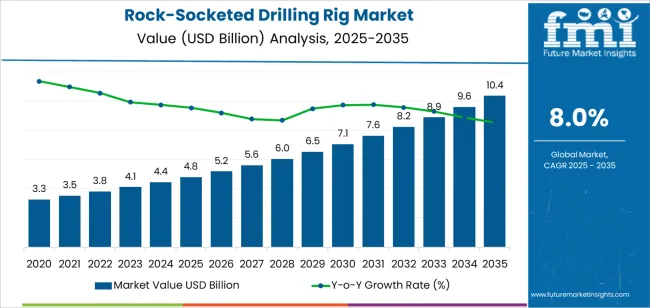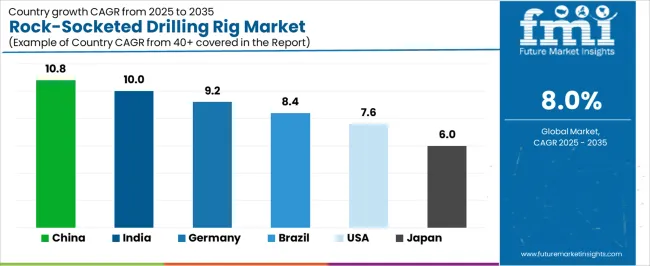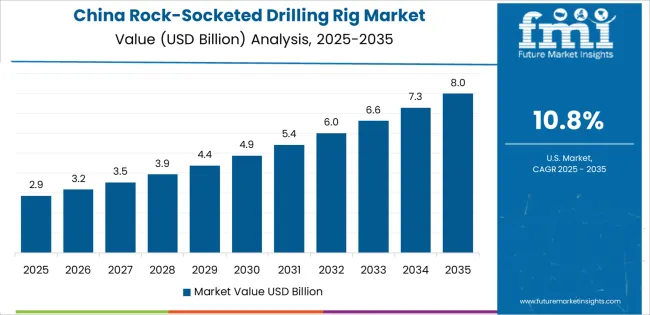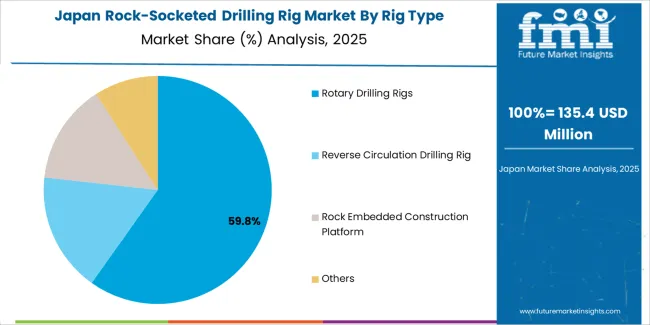The rock-socketed drilling rig market is valued at USD 4.8 billion in 2025. It is expected to reach USD 10.4 billion by 2035, driven by steady expansion in deep foundation engineering, large-scale civil infrastructure, and offshore construction. Demand is being strengthened by bridge foundation projects, metro and tunnel developments, high-rise building construction, and new port expansion initiatives, where rock anchoring strength and borehole stability are critical. Rock-socketed drilling rigs enable controlled penetration into hard geological formations, providing foundation integrity in conditions where conventional piling equipment cannot perform. As governments and private developers prioritize resilient structural frameworks, equipment selection increasingly focuses on efficiency, drilling torque capacity, and compatibility with variable ground conditions.
From 2025 to 2030, the market will increase from USD 4.8 billion to approximately USD 6.6 billion, adding USD 1.7 billion in value and accounting for 41 percent of the decade’s total expansion. This stage is defined by the rapid adoption of rotary drilling rigs, driven by urban development and transportation corridor projects across Asia-Pacific, the Middle East, and Latin America. Contractors require rigs that ensure consistent borehole formation, minimal deviation, and stable, socketed base construction. Automation in drilling parameter control, real-time ground condition monitoring, and wear-resistant drilling components becomes a normalized procurement criterion. Suppliers with integrated service capabilities, operator training programs, and remote maintenance platforms maintain a stronger competitive standing as operational reliability becomes a primary purchasing determinant.

The latter half (2030-2035) will witness continued growth from USD 6.6 billion to USD 10.4 billion, adding USD 3.9 billion, or 59% of the decade's expansion. This period will be defined by mass market penetration of high-performance drilling technologies, integration with comprehensive project management platforms, and seamless compatibility with existing construction infrastructure. The market trajectory signals fundamental shifts in how construction facilities approach foundation drilling and quality management, with participants positioned to benefit from growing demand across multiple rig types and application segments.
| Period | Primary Revenue Buckets | Share | Notes |
|---|---|---|---|
| Today | New rig sales (rotary, reverse circulation, rock embedded) | 51% | Capex-led, project-driven purchases |
| Spare parts & consumables | 21% | Drilling tools, bits, maintenance components | |
| Service & maintenance contracts | 18% | Preventive maintenance, repair support | |
| Upgrades & retrofits | 10% | Technology enhancement, capacity expansion | |
| Future (3-5 yrs) | High-performance rotary rigs | 44-49% | Smart drilling, automation integration |
| Digital monitoring & analytics | 14-18% | Real-time performance tracking, predictive maintenance | |
| Service-as-a-subscription | 13-17% | Performance guarantees, outcome-based pricing | |
| Consumables & tooling | 11-15% | Precision drilling bits, specialized tools | |
| Validation & compliance services | 7-11% | Safety certification, quality documentation | |
| Data services (drilling efficiency, safety metrics, project tracking) | 5-8% | Benchmarking for contractors |
| Metric | Value |
|---|---|
| Market Value (2025) | USD 4.8 billion |
| Market Forecast (2035) | USD 10.4 billion |
| Growth Rate | 8.0% CAGR |
| Leading Technology | Rotary Drilling Rigs |
| Primary Application | Construction Segment |
The market demonstrates strong fundamentals with rotary drilling rigs capturing a dominant share through advanced precision drilling capabilities and construction project optimization. Construction applications drive primary demand, supported by increasing infrastructure development and foundation drilling requirements. Geographic expansion remains concentrated in developed markets with established construction infrastructure, while emerging economies show accelerating adoption rates driven by local infrastructure initiatives and rising safety standards.
Primary Classification: The market segments by rig type into reverse circulation drilling rigs, rotary drilling rigs, rock embedded construction platforms, and other categories, representing the evolution from basic drilling equipment to sophisticated foundation solutions for comprehensive construction optimization.
Secondary Classification: Application segmentation divides the market into offshore wind power, construction, mining, and other sectors, reflecting distinct requirements for drilling specifications, operational efficiency, and project delivery standards.
Regional Classification: Geographic distribution covers North America, Latin America, Western Europe, Eastern Europe, East Asia, South Asia Pacific, and Middle East & Africa, with developed markets leading adoption while emerging economies show accelerating growth patterns driven by infrastructure expansion programs.
The segmentation structure reveals technology progression from standard drilling equipment toward sophisticated drilling systems with enhanced precision and automation capabilities, while application diversity spans from construction facilities to offshore operations requiring specialized drilling solutions.

Market Position: Rotary Drilling Rigs command the leading position in the rock-socketed drilling rig market with 59% market share through advanced drilling features, including superior penetration capability, operational efficiency, and construction project optimization that enable contractors to achieve optimal foundation performance across diverse construction and infrastructure environments.
Value Drivers: The segment benefits from construction contractor preference for reliable drilling systems that provide consistent performance, reduced project timeline, and operational efficiency optimization without requiring significant site modifications. Advanced design features enable automated depth control systems, drilling consistency, and integration with existing construction equipment, where operational performance and safety compliance represent critical project requirements.
Competitive Advantages: Rotary Drilling Rigs differentiate through proven operational reliability, consistent drilling characteristics, and integration with automated construction management systems that enhance project effectiveness while maintaining optimal safety standards suitable for diverse construction and infrastructure applications.
Key market characteristics:
Reverse Circulation Drilling Rigs maintain a 27% market position in the rock-socketed drilling rig market due to their balanced performance properties and sample quality advantages. These systems appeal to projects requiring superior drilling sample recovery with competitive pricing for mining and geotechnical applications. Market growth is driven by mining expansion, emphasizing reliable drilling solutions and operational efficiency through optimized system designs.
Rock Embedded Construction Platforms capture 9% market share through specialized drilling requirements in offshore facilities, marine construction, and complex foundation applications. These projects demand robust drilling systems capable of handling challenging geological conditions while providing effective foundation capabilities and operational reliability.
Other Rig applications account for 5% market share, including specialized drilling equipment, custom solutions, and unique project requirements demanding tailored drilling capabilities for operational optimization and application-specific needs.

Market Position: Construction applications command a significant market position with 40% share, driven by infrastructure development requirements and widespread adoption across global construction markets.
Value Drivers: This application segment provides the primary demand source for rock-socketed drilling rigs, meeting requirements for deep foundation construction, bridge piers, high-rise buildings, and infrastructure projects without excessive operational complexity or safety variation.
Growth Characteristics: The segment benefits from broad applicability across construction sectors, standardized drilling specifications, and established project programs that support widespread adoption and operational efficiency.
Offshore Wind Power applications capture 30% of the market share, driven by specialized drilling requirements for renewable energy projects and marine foundations. These projects demand precision drilling rigs capable of handling challenging offshore conditions while ensuring foundation stability and project delivery.
Mining applications account for 20% of the market share, including exploration drilling, ore body delineation, and geotechnical investigation. These applications require reliable drilling capabilities for operational optimization and resource evaluation.
Other applications account for 10% of the market share, including geothermal drilling, water well construction, and specialty foundation projects requiring customized drilling rig solutions for operational optimization and application-specific requirements.
| Category | Factor | Impact | Why It Matters |
|---|---|---|---|
| Driver | Infrastructure development & urbanization trends | ★★★★★ | Growing construction activities require efficient, reliable drilling rigs with consistent quality and deep foundation capabilities. |
| Driver | Offshore wind energy expansion & renewable projects | ★★★★★ | Expanding renewable energy sector drives demand for specialized drilling equipment; suppliers providing marine-grade rigs gain competitive advantage. |
| Driver | Mining sector growth & resource exploration | ★★★★☆ | Mineral exploration requires advanced drilling systems; demand for high-performance reverse circulation rigs in mining operations expanding addressable market. |
| Restraint | High capital investment & operational costs | ★★★★☆ | Small contractors defer purchases; increases price sensitivity and slows advanced equipment adoption in developing markets. |
| Restraint | Skilled operator shortage & training requirements | ★★★☆☆ | Construction sites face operator availability challenges and certification requirements, limiting deployment flexibility and increasing operational complexity. |
| Trend | Automation & digitalization integration | ★★★★★ | Real-time monitoring, automated drilling control, and data analytics transform operations; smart drilling capabilities become core value propositions. |
| Trend | Safety enhancement & environmental compliance | ★★★★☆ | Stringent safety regulations drive advanced protection systems; environmentally friendly drilling solutions and emission reduction capabilities differentiate suppliers in regulated markets. |
The rock-socketed drilling rig market demonstrates varied regional dynamics with Growth Leaders including China (10.8% growth rate) and India (10.0% growth rate) driving expansion through infrastructure initiatives and construction capacity development. Steady Performers encompass United States (7.6% growth rate), Germany (9.2% growth rate), and developed regions, benefiting from established construction industries and advanced drilling adoption. Emerging Markets feature Brazil (8.4% growth rate) and developing regions, where infrastructure initiatives and construction modernization support consistent growth patterns.
Regional synthesis reveals East Asian markets leading adoption through infrastructure expansion and offshore development, while North American countries maintain steady expansion supported by construction technology advancement and safety standardization requirements. European markets show moderate growth driven by renewable energy applications and drilling technology integration trends.

| Region/Country | 2025-2035 Growth | How to win | What to watch out |
|---|---|---|---|
| China | 10.8% | Lead with high-capacity rotary rigs | Overcapacity risks; quality standards |
| India | 10.0% | Focus on cost-effective solutions | Infrastructure delays; financing challenges |
| Germany | 9.2% | Offer premium automated systems | Over-engineering; certification complexity |
| Brazil | 8.4% | Value-oriented models | Economic volatility; project cancellations |
| United States | 7.6% | Provide safety support | Labor shortages; regulatory compliance |
| Japan | 6.0% | Push advanced technology | Market saturation; demographic decline |

China establishes fastest market growth through aggressive infrastructure programs and comprehensive construction capacity development, integrating advanced rock-socketed drilling rigs as standard equipment in bridge construction and offshore wind installations. The country's 10.8% growth rate reflects government initiatives promoting infrastructure development and domestic construction capabilities that mandate the use of advanced drilling systems in construction and renewable energy facilities. Growth concentrates in major infrastructure regions, including Yangtze River Delta, Pearl River Delta, and Bohai Rim, where construction technology development showcases integrated drilling rig systems that appeal to contractors seeking advanced foundation optimization capabilities and project management applications.
Chinese manufacturers are developing cost-effective drilling rig solutions that combine domestic production advantages with advanced operational features, including automated control systems and enhanced drilling capabilities. Distribution channels through construction equipment suppliers and project contractors expand market access, while government support for infrastructure development supports adoption across diverse construction and offshore segments.
Strategic Market Indicators:
In Mumbai, Delhi, and Bangalore, construction contractors and infrastructure developers are implementing advanced rock-socketed drilling rigs as standard equipment for project optimization and foundation quality applications, driven by increasing government infrastructure investment and modernization programs that emphasize the importance of drilling efficiency capabilities. The market holds a 10.0% growth rate, supported by government smart city initiatives and infrastructure development programs that promote advanced drilling systems for construction and mining facilities. Indian operators are adopting drilling rigs that provide consistent operational performance and safety compliance features, particularly appealing in regions where project efficiency and quality standards represent critical operational requirements.
Market expansion benefits from growing construction capabilities and technology transfer agreements that enable domestic production of advanced drilling rigs for infrastructure applications. Technology adoption follows patterns established in construction equipment, where reliability and performance drive procurement decisions and project deployment.
Market Intelligence Brief:
Advanced construction technology market in Germany demonstrates sophisticated rock-socketed drilling rig deployment with documented operational effectiveness in infrastructure applications and construction projects through integration with existing safety systems and project management infrastructure. The country leverages engineering expertise in construction technology and safety systems integration to maintain a 9.2% growth rate. Industrial centers, including Bavaria, Baden-Württemberg, and North Rhine-Westphalia, showcase premium installations where drilling rigs integrate with comprehensive project platforms and contractor management systems to optimize construction operations and safety effectiveness.
German manufacturers prioritize system automation and EU compliance in drilling rig procurement, creating demand for premium equipment with advanced features, including project monitoring integration and automated safety systems. The market benefits from established construction technology infrastructure and a willingness to invest in advanced drilling technologies that provide long-term operational benefits and compliance with international safety standards.
Market Intelligence Brief:
Brazil's market expansion benefits from diverse infrastructure demand, including construction modernization in São Paulo and Rio de Janeiro, mining facility development, and government infrastructure programs that increasingly incorporate drilling rig solutions for project optimization applications. The country maintains a 8.4% growth rate, driven by rising infrastructure activity and increasing recognition of advanced drilling technology benefits, including precise foundation control and enhanced project efficiency.
Market dynamics focus on cost-effective drilling rig solutions that balance advanced operational performance with affordability considerations important to Brazilian contractors. Growing infrastructure development creates continued demand for modern drilling systems in new construction projects and mining expansion initiatives.
Strategic Market Considerations:
United States establishes market leadership through comprehensive infrastructure programs and advanced construction technology development, integrating rock-socketed drilling rigs across bridge construction and foundation applications. The country's 7.6% growth rate reflects established construction industry relationships and mature drilling technology adoption that supports widespread use of precision drilling rigs in infrastructure projects. Growth concentrates in major construction markets, including Texas, California, and New York, where construction technology showcases mature drilling rig deployment that appeals to contractors seeking proven drilling capabilities and operational efficiency applications.
American equipment providers leverage established distribution networks and comprehensive safety capabilities, including operator training programs and compliance support that create customer relationships and operational advantages. The market benefits from mature safety standards and construction requirements that mandate drilling rig use while supporting technology advancement and operational optimization.
Market Intelligence Brief:
United Kingdom's construction technology market demonstrates established rock-socketed drilling rig deployment with documented operational effectiveness in infrastructure applications and construction projects through integration with existing safety systems and project management infrastructure. The country maintains a 6.8% growth rate. Construction centers, including South East England, North West England, and Scotland, showcase installations where drilling rigs integrate with comprehensive project platforms and contractor management systems to optimize construction operations and safety effectiveness.
British contractors prioritize safety compliance and operational efficiency in drilling rig procurement, creating demand for equipment with advanced features, including digital monitoring integration and automated safety systems. The market benefits from established construction infrastructure and safety standards that support technology advancement and operational optimization.
Market Intelligence Brief:

The European rock-socketed drilling rig market is projected to grow from USD 1,751.9 million in 2025 to USD 4,167.5 million by 2035, registering a CAGR of 9.0% over the forecast period. Germany is expected to maintain its leadership position with a 35.8% market share in 2025, supported by its advanced construction technology infrastructure and major infrastructure development centers.
United Kingdom follows with a 22.1% share in 2025, driven by comprehensive infrastructure programs and construction technology development initiatives. France holds a 18.4% share through specialized construction applications and safety compliance requirements. Italy commands a 12.9% share, while Spain accounts for 10.8% in 2025. The rest of Europe region is anticipated to gain momentum, expanding its collective share from 6.3% to 6.8% by 2035, attributed to increasing rock-socketed drilling rig adoption in Nordic countries and emerging Eastern European facilities implementing infrastructure modernization programs.

Japan's rock-socketed drilling rig market demonstrates sophisticated deployment with documented operational effectiveness in infrastructure and disaster prevention applications through integration with existing safety systems and construction infrastructure. The country maintains a 6.0% growth rate, supported by established construction operations and premium quality requirements. Construction centers showcase advanced drilling rig installations where precision drilling capabilities and safety management features align with Japanese construction standards and earthquake-resistant foundation expectations.
Japanese contractors prioritize equipment reliability and safety compliance in drilling rig procurement, creating demand for premium equipment with advanced automation features. The market benefits from established safety standards and mature construction infrastructure, though market maturity and demographic challenges moderate growth potential compared to emerging Asian markets.

South Korea's rock-socketed drilling rig market demonstrates technology-focused adoption with emphasis on automated drilling systems and safety compliance across construction operations. The market maintains steady growth driven by infrastructure modernization and offshore wind development. Construction facilities in Gyeonggi and South Chungcheong provinces showcase modern drilling rig installations where automation capabilities and safety management features support infrastructure positioning and technology competitiveness in regional markets.

The rock-socketed drilling rig market features 18-22 credible players with top 5 companies holding approximately 62-66% market share by revenue. Leadership is maintained through service networks, safety certification capabilities, and technology innovation focused on drilling performance, automation integration, and project efficiency capabilities.
Structure: Market concentration reflects established equipment manufacturers with proven drilling technology and comprehensive service capabilities. Regional players maintain presence through localized support networks and cost-competitive offerings, while global leaders leverage technology innovation and extensive distribution infrastructure.
Leadership is maintained through: extensive service networks, safety certification capabilities, and technology innovation emphasizing drilling speed, penetration depth, automation control, and digital monitoring integration.
What's commoditizing: basic drilling mechanisms and standard monitoring systems face increasing price pressure as technology matures and alternative suppliers emerge with comparable performance specifications.
Margin Opportunities: technical support services, operator training assistance, and integration into customer workflows including safety certification, maintenance protocols, and project management platforms provide differentiation beyond equipment sales.
| Stakeholder | What they actually control | Typical strengths | Typical blind spots |
|---|---|---|---|
| Global platforms | Distribution reach, deep product catalogs, service networks | Broad availability, proven reliability, multi-region support | Technology refresh cycles; aftermarket dependency |
| Technology innovators | R&D capabilities; automated drilling systems; clean digital interfaces | Latest features first; attractive ROI on large projects | Service density outside core regions; customization complexity |
| Regional specialists | Local compliance, fast delivery, nearby technicians | Close to site support; pragmatic pricing; local regulations | Technology gaps; talent retention in service |
| Service-focused ecosystems | Training support, maintenance SLAs, spare parts availability | Lowest downtime; comprehensive support | Service costs if overpromised; technology obsolescence |
| Niche specialists | Specialized applications, custom solutions, offshore support | Win complex/marine projects; flexible configurations | Scalability limitations; narrow market focus |
Market dynamics favor equipment providers demonstrating comprehensive safety compliance capabilities, rapid service response networks, and proven integration with existing construction processes. Technology advancement focuses on drilling efficiency through automated control systems, digital monitoring for safety assurance, and seamless connectivity with project management platforms. Competitive differentiation increasingly relies on service capabilities and automation features rather than basic drilling performance specifications.
| Item | Value |
|---|---|
| Quantitative Units | USD 4.8 billion |
| Rig Type | Reverse Circulation Drilling Rig, Rotary Drilling Rig, Rock Embedded Construction Platform, Others |
| Application | Offshore Wind Power, Construction, Mining, Others |
| Regions Covered | North America, Latin America, Western Europe, Eastern Europe, East Asia, South Asia Pacific, Middle East & Africa |
| Countries Covered | China, India, Germany, Brazil, United States, United Kingdom, Japan, South Korea, and 20+ additional countries |
| Key Companies Profiled | Dando Drilling Ltd, Soilmec S.p.A, Naugra, Koken Boring Machine Co., Ltd., Mastenbroek Limited, Tesmec SpA, Shandong Binzhou Forging and Pressing Machinery FACTORY, Shandong Hengwang Group Co., Ltd., Zhangjiakou Xuanhua Jinke Drilling Machinery Co., Ltd, Xuzhou JingAn Heavy Industry Manufacture Co., Ltd., Middling Coal Special Sinking Co., Ltd., HENGTONG Group Co., Ltd., CITIC Heavy Industries Co., Ltd., Jiangsu Longyuan Zhenhau Marine Engineering Co., Ltd., Zhengli Ocean Engineering Co., Ltd., SANY Group Co., Ltd., Sunward Intelligent Equipment Co., Ltd., Zoomlion Heavy Industry Science & Technology Co., Ltd. |
| Additional Attributes | Dollar sales by rig type and application categories, regional adoption trends across East Asia, South Asia Pacific, and Western Europe, competitive landscape with drilling equipment manufacturers and construction machinery suppliers, contractor preferences for drilling precision control and equipment reliability, integration with project management platforms and safety monitoring systems, innovations in drilling technology and automation enhancement, and development of advanced rock-socketed drilling solutions with enhanced performance and construction optimization capabilities. |
The global rock-socketed drilling rig market is estimated to be valued at USD 4.8 billion in 2025.
The market size for the rock-socketed drilling rig market is projected to reach USD 10.4 billion by 2035.
The rock-socketed drilling rig market is expected to grow at a 8.0% CAGR between 2025 and 2035.
The key product types in rock-socketed drilling rig market are rotary drilling rigs , reverse circulation drilling rig, rock embedded construction platform and others.
In terms of application, construction segment to command 40.0% share in the rock-socketed drilling rig market in 2025.






Full Research Suite comprises of:
Market outlook & trends analysis
Interviews & case studies
Strategic recommendations
Vendor profiles & capabilities analysis
5-year forecasts
8 regions and 60+ country-level data splits
Market segment data splits
12 months of continuous data updates
DELIVERED AS:
PDF EXCEL ONLINE
Drilling Tools Market Size and Share Forecast Outlook 2025 to 2035
Drilling Type EDM Market Size and Share Forecast Outlook 2025 to 2035
Drilling Machines Market Size and Share Forecast Outlook 2025 to 2035
Drilling and Completion Fluids Market Diapers Market Analysis - Size, Share & Forecast 2025 to 2035
Drilling Polymers Market Analysis, Growth, Applications and Outlook 2025 to 2035
Laser Drilling Equipment Market Size and Share Forecast Outlook 2025 to 2035
Mining Drilling Service Market Size and Share Forecast Outlook 2025 to 2035
Radial Drilling Machine Market Growth & Demand 2025 to 2035
Rotary Drilling Rig Market Size and Share Forecast Outlook 2025 to 2035
Onshore Drilling Waste Management Market Size and Share Forecast Outlook 2025 to 2035
Onshore Drilling Fluids Market Growth - Trends & Forecast 2025 to 2035
Crawler Drilling Machine Market
Surface Drilling Rigs Market
Offshore Drilling Riser Market Size and Share Forecast Outlook 2025 to 2035
Multi Pad Drilling Market Size and Share Forecast Outlook 2025 to 2035
Directional Drilling Service Market Forecast Outlook 2025 to 2035
Diamond Core Drilling Market Analysis - Size, Share, and Forecast Outlook 2025 to 2035
Competitive Overview of Diamond Core Drilling Market Share
Multi-Axis PCB Drilling Machine Market Size and Share Forecast Outlook 2025 to 2035
Hydraulic Anchor Drilling Vehicle for Mining Market Size and Share Forecast Outlook 2025 to 2035

Thank you!
You will receive an email from our Business Development Manager. Please be sure to check your SPAM/JUNK folder too.
Chat With
MaRIA